Preserved Lemons
This post may contain affiliate links. See my disclosure policy.
Get ready to unlock one of the grand secrets of Moroccan and Middle Eastern cuisine by learning how to make preserved lemons in this step-by-step tutorial. These homemade preserved lemons are a powerhouse ingredient that will infuse your dishes with such an incredible flavor and absolutely transform any dish you add them to, whether savory or sweet. Just a few minutes of your time will give you this magical ingredient that keeps for months and you can enjoy all the year through!
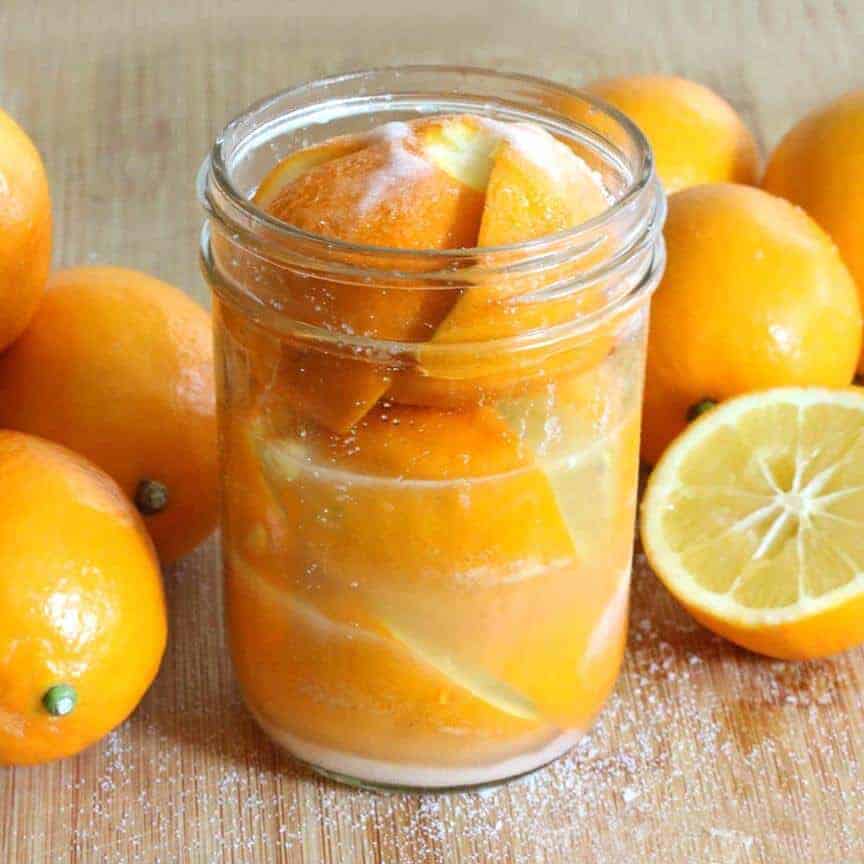
If you’re a fan of Moroccan and Middle Eastern cooking you’ve probably had the experience of thumbing through recipes, drooling all the while, earmarking the ones you particularly like, only to then scan through the ingredients and see the words: “Preserved Lemons”. Your heart sinks for a moment as you realize you are sorely lacking this crucial ingredient. And so with disappointment you un-earmark that page and move on to the next recipe. DON’T let that scenario stop you again. Because nothing could be easier than making your own DIY preserved lemons! These are one of my most favorite “secret” ingredients and I’m going to show you exactly how to make them and how to use them in lots of delicious ways!
What Are Preserved Lemons?
Preserved lemons are lemons that have been packed in salt and their own juices and are left to cure for about a month. During that time the flavors transform in which the acidic tartness disappears and you’re left with a very amplified and complex lemon flavor. Think of preserved lemons as lemons on steroids. They add an intense, concentrated lemon flavor to the dish without all the sour tartness. The preserving process tempers the tartness while accentuating the lemon flavor. In other words, mildly tart but intensely lemony. And if you’re a lover of all things lemon, preserved lemons need a permanent place in your pantry. I can assure you, there is virtually always a jar of these in my fridge!
This preservation process also extends the shelf life of the lemons and they’ll keep for around 6 months in your fridge and even longer if you can them. Over time the lemons become soft and to use them you simply remove however much you need, scrape off the fleshy interior, rinse off the peel, dice it up, and add it to your dishes. Preserved lemons have been around for centuries and are used extensively in Middle Eastern and North African cuisines, most famously Moroccan food. Their unique flavor adds an incredible amount of flavor to a wide variety of savory dishes and desserts.
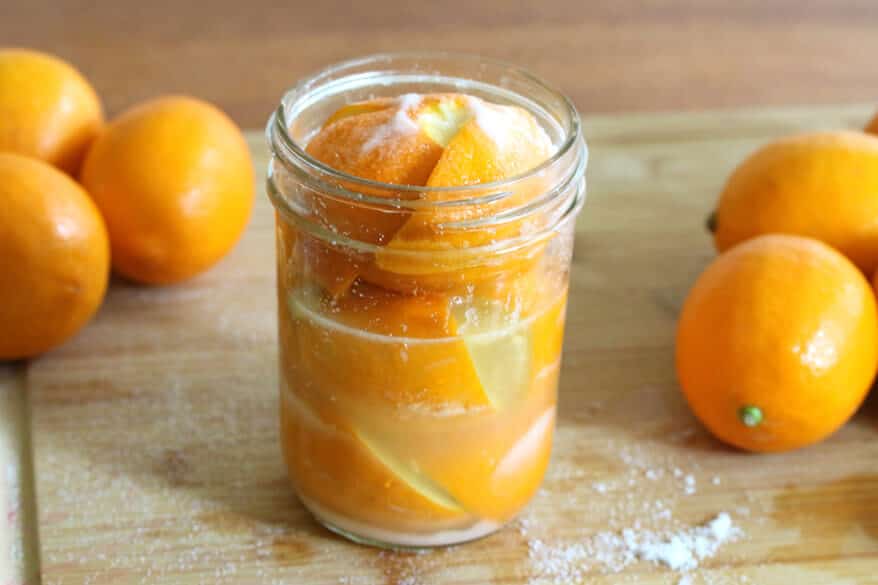
How to Use Preserved Lemons
You’ll find preserved lemons called for in a lot of Middle Eastern and Moroccan recipes, everything from tagines to stews and salads and add a uniquely tangy, salty, and mildly sweet flavor. They can be added to any dish that calls for or can benefit from a touch of lemon flavor. And that includes desserts. Here are just a few ways to use preserved lemons:
- Tagines and stews: a little goes a long way to adding life and flavor. Try them in my Moroccan Harira and Moroccan Chicken Tagine. They’re also great in a variety of bean stews and lentil soups.
- Chicken, duck, beef, lamb, pork, and fish: preserved lemons pair beautifully with any protein. Try them in my Moroccan Chicken (Djej Makalli). And of course lemon and seafood are soulmates. Now just wait until you’ve paired it with preserved lemons and your life is forever changed.
- Salads: Finely mince and toss them into your salads, including pasta salads. They also pair beautifully with grain salads and grain bowls. Try them in two of my personal favorites, this Moroccan Chicken Salad and Curried Couscous Salad.
- Rice, grain, and pasta dishes: try them in my Salmon Risotto – it’s a match made in heaven.
- Marinades: Incorporate them into marinades for chicken, lamb, pork and fish. They add just touch of acidity and a whole depth of flavor.
- Dressings, sauces and dips : Blend them into dressings, vinaigrettes and sauces for an exciting flavor punch. They also work really well in creamy sauces. Add some to your Hummus or Baba Ganoush or to some Greek yogurt along with fresh dill for a refreshing dip.
- Sandwiches and Wraps: you can even add them to your burgers for a fun flavor boost. Oh, and add them to Falafel!
- Salsas and Relishes: chop some up and it to your salsas and relishes for a unique lemony twist like my Mango Salsa and Pineapple Salsa.
- Roasted Vegetables: Toss your roasted veggies with some butter and finely minced preserved lemons for a fabulous flavor. They pair particularly well with root vegetables and cauliflower.
- Cakes, Cupcakes, Muffins, etc: Anything that you would add lemon zest to, try adding some finely minced preserved lemon. Try it in our Preserved Lemon and Ginger Pound Cake.
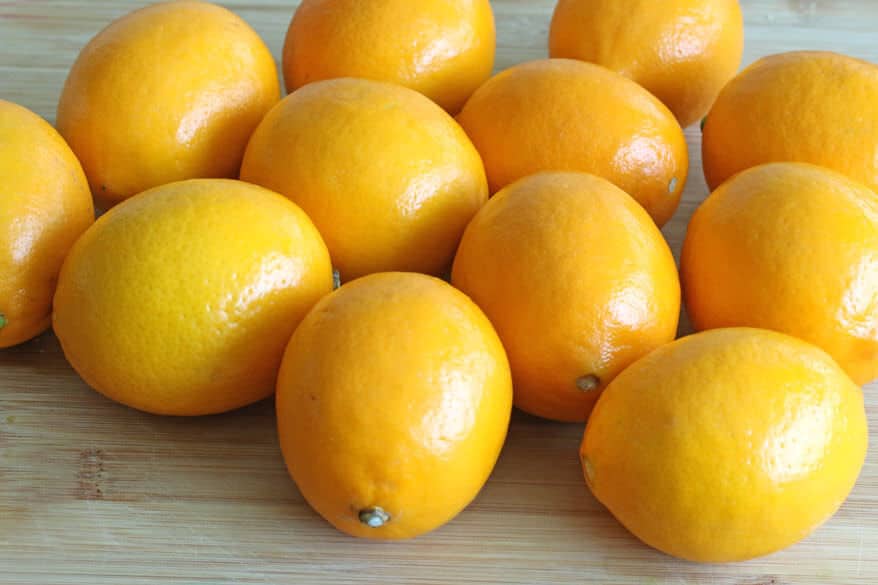
What Kind of Lemons Are Best?
Doqq and boussera lemons are commonly used in Morocco. They have thinner skins and are sweeter than regular lemons. A great substitute is Meyer lemons. If you can’t find Meyer lemons you can use regular lemons such as Eureka or Lisbon. Organic is ideal since it’s the lemon rinds that are eaten.
Variations
Did you know, you can also make preserved limes, oranges, grapefruit and kumquats! The process is identical but because high acidity is required for proper preservation and other citrus varieties have a lower acid content, you will still need to top off the jars with lemon juice. Experiment with these other citrus varieties for some fun flavor variations.
How Long Do Preserved Lemons Last?
Preserved lemons can be stored at room temperature but they’ll ferment very quickly that way and won’t keep as long. It’s recommended to store them in the fridge, in a glass jar with a lid, where they will keep for up to 6 months, and quite possibly longer. Just check periodically for any signs of mold or off colors and smells.
Preserved Lemons Recipe
Let’s get started!
Organic is ideal if you can find them since it’s the rinds that are eaten. If you can’t find organic, let the lemons soak in a vinegar-water solution for a few minutes to clean the outer peels, then rinse.
Trim the nubs off both ends of each lemon.
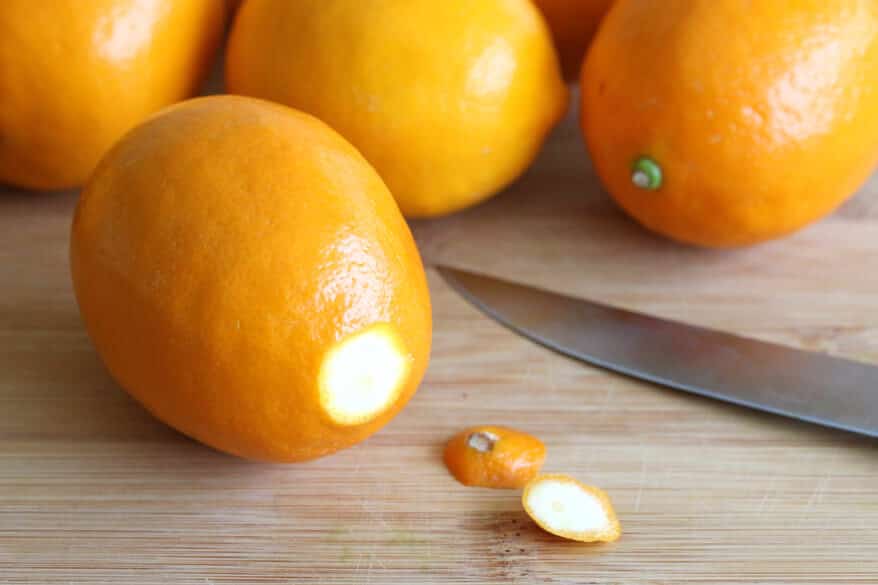
Slice the lemons into quarters, leaving the ends attached. So slice down just a little over 3/4 of the way.
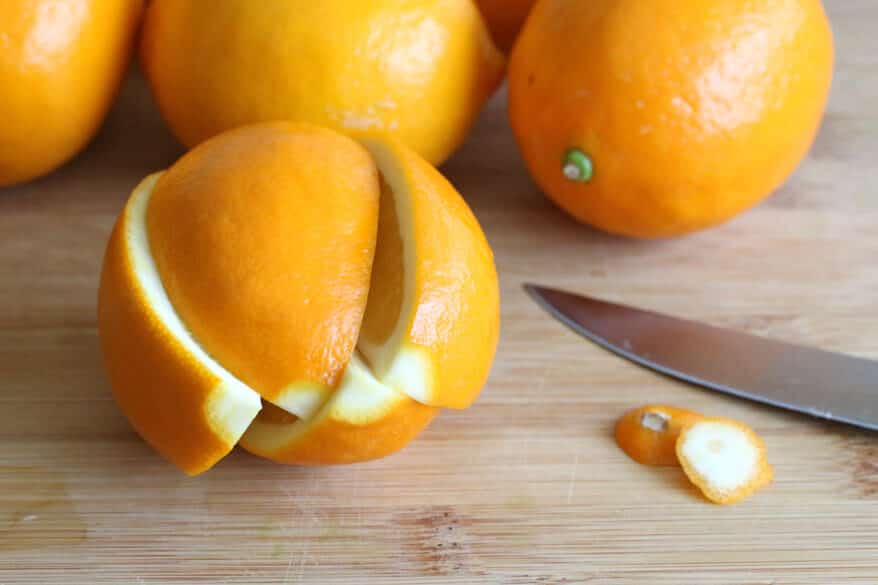
Put a teaspoon of salt in the bottom of a pint-sized jar. Put another teaspoon of salt into the quartered lemon.
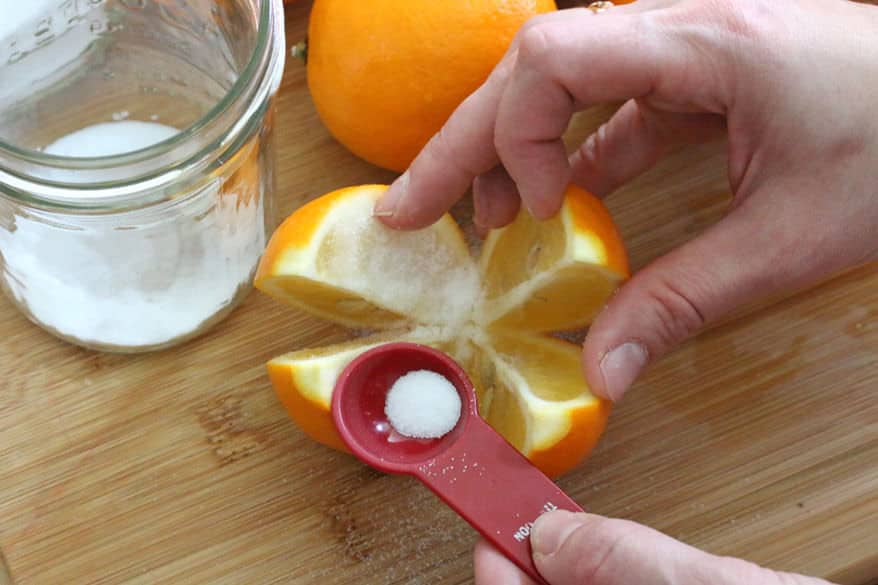
Stuff the lemon into the jar, open end down, and push hard to squish it and release its juices.
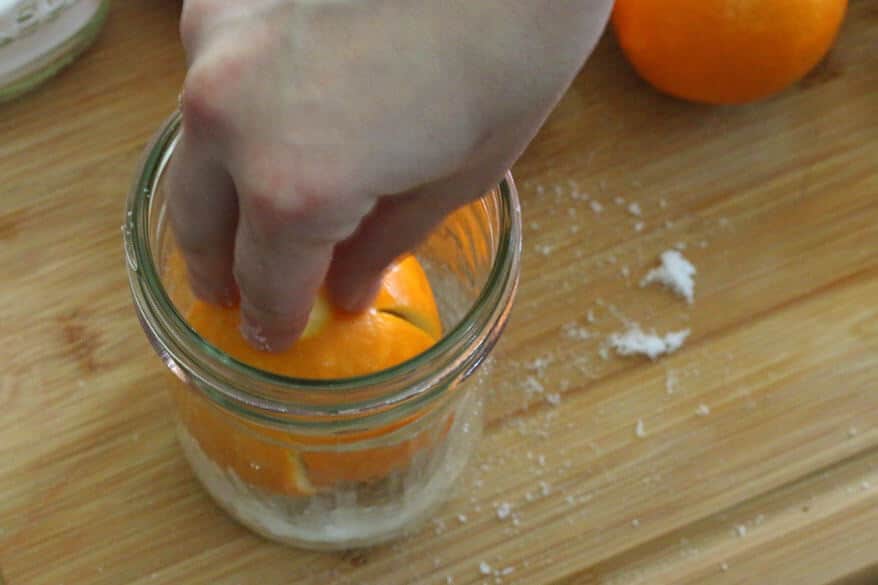
Put a teaspoon of salt over the top of the lemon.
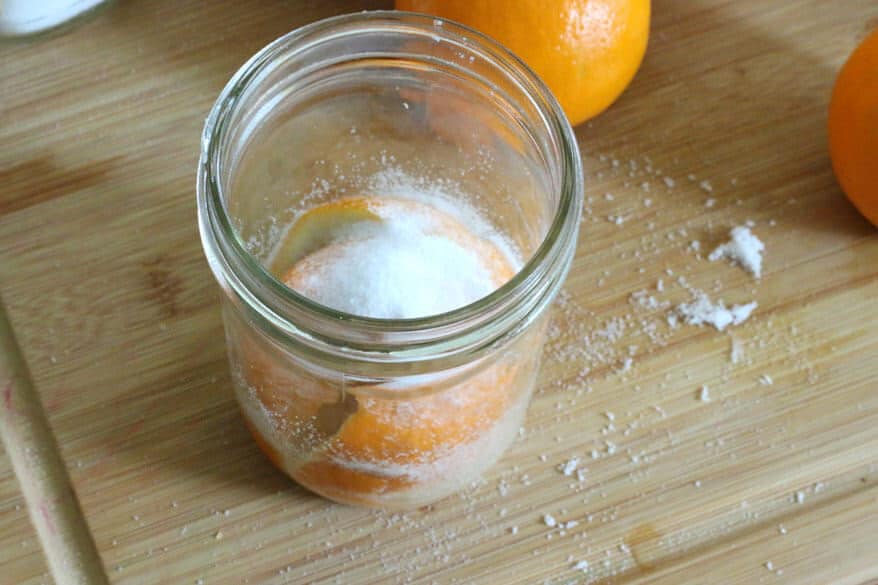
Repeat the process, putting a teaspoon of salt inside the second lemon, and then squish it down hard on top of the first lemon.
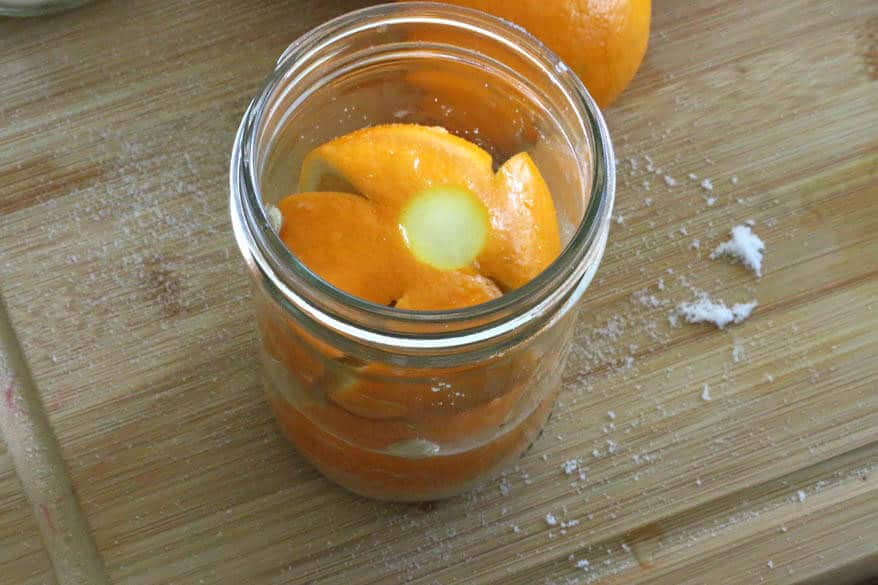
You got it – add another teaspoon of salt on top of the second lemon, and repeat the process for the third and final lemon. Add a teaspoon of salt on the very top. The jar should be at least halfway full of lemon juice from having compressed the lemons. If needed, squeeze some extra lemon juice into the jar to bring it to the halfway point. And don’t waste that lemon – cut it up and stuff it into the jar. Now pour some water that’s been boiled and cooled (sterile) into the jar to fill it up the rest of the way. Repeat this process for however many jars you wish to make.
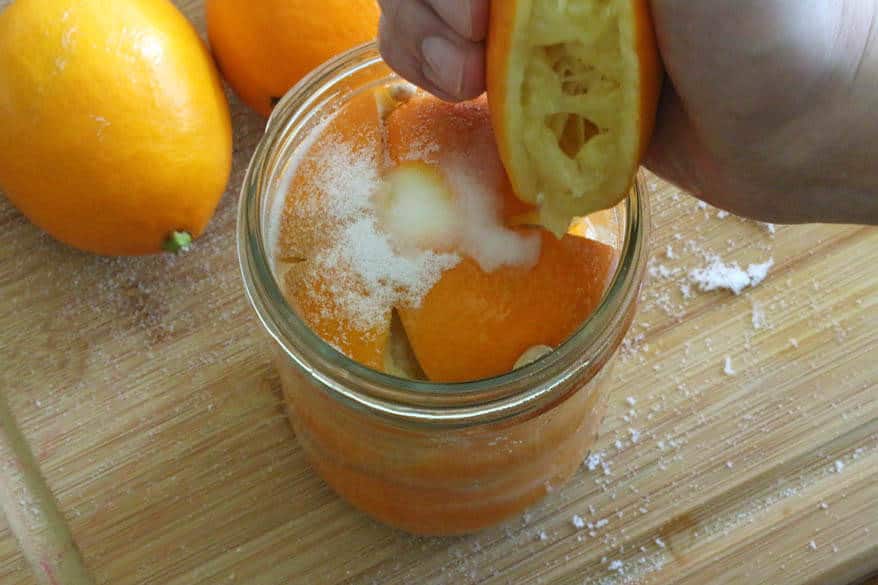
After you add the water, screw on the lid and let the jar sit at room temperature for 3 days, giving it a shake and turn it upside-down/right-side up a few times a day. After 3 days place the jar in the refrigerator and let it sit for at least 3 weeks before using. Keep the jar in the refrigerator. Whatever dish you use them in, discard the pulp (it’s the peel that is used) and thoroughly wash the peel to remove excess salt.
That’s it! Your preserved lemons are ready! *Taste bud choir breaks out into a stirring rendition of the “Hallelujah Chorus”*
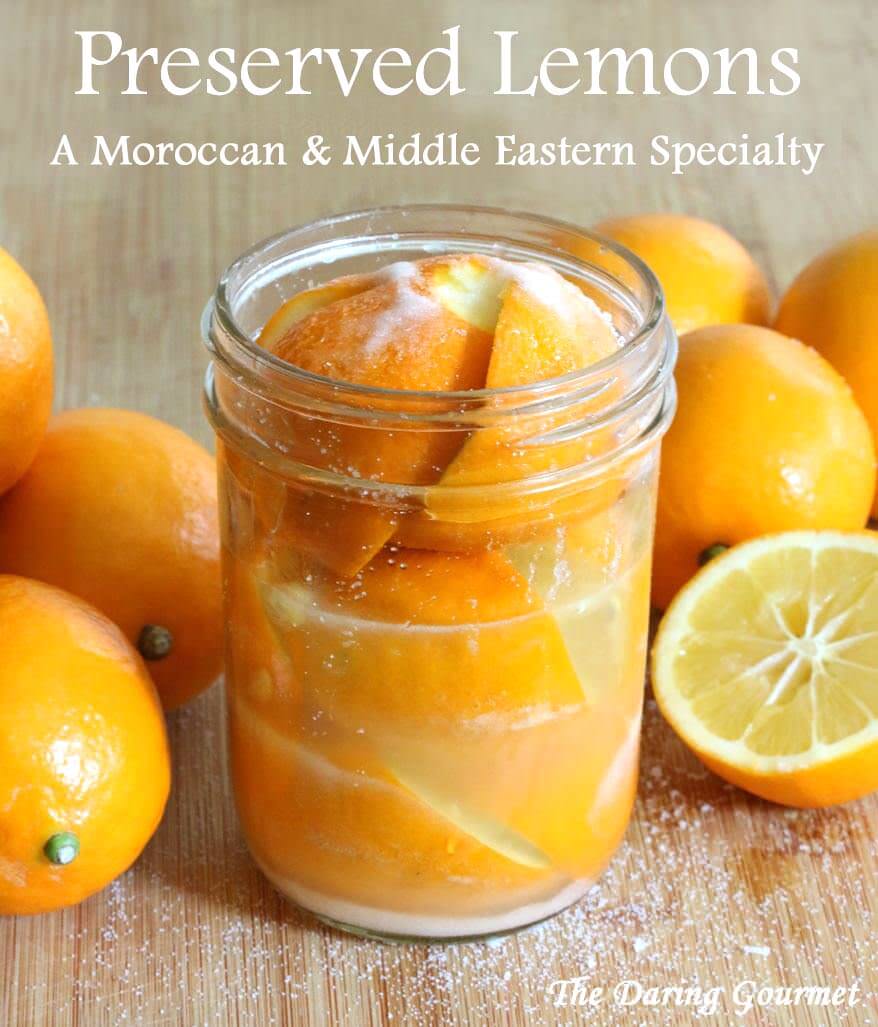
Save This Recipe

Preserved Lemons
Ingredients
- 3 Meyer lemons , or Eureka, Lisbon, etc, organic recommended per pint-sized jar
- 5-6 teaspoons sea salt or kosher salt (regular table salt contains iodine which will turn the lemons gray)
- An extra lemon for juicing
- Water that has been boiled and cooled sterile
Instructions
- Note: you can make however many preserved lemons you like, but roughly 3 will fit per pint-sized jar.Thoroughly clean the lemons. Organic is recommended. If you can't find organic, let the lemons sit in some vinegar water for a few minutes, then rinse.Trim the nubs off both ends of each lemon. Quarter each lemon, slicing them down just over 3/4 of the way to leave the slices attached at the end.Put one teaspoon of salt into the cavity of each lemon.Place one teaspoon salt into the bottom of the jar. Put a lemon in the jar, cut-side down, pressing firmly to squish out the lemon juice. Put a teaspoon of salt on top of the lemon. Firmly press the second lemon down on top of the first lemon. Repeat with the third lemon, pressing down firmly. Add a teaspoon of salt on top of the lemon.The jar should be at least halfway full with lemon juice. If needed, squeeze some additional lemon juice into the jar to bring it to the halfway point. Don't waste that lemon; slice it and stuff the slices into the jar. Pour the boiled/cooled water into the jar to fill it to the top.Screw the lid on and let it sit at room temperature for 3 days, shaking it and rotating the jar upside-down/right-side up a few times per day. After 3 days transfer the jars to the refrigerator and let them sit for at least 3 weeks before using. Stored in the fridge, they will keep for at least 6 months (see note).
Notes
* Whatever dish you use them in, discard the pulp (it’s the peel that is used) and thoroughly wash the peel to remove excess salt. * Using other citrus: You can also make preserved limes, oranges, grapefruit and kumquats! The process is identical but because high acidity is required for proper preservation you will still need to top off the jars with lemon juice.
Nutrition
Originally published on The Daring Gourmet April 8, 2014



















Do you think boiling the lemon after cutting will help to make the skin more soft
Hi Nikhil, I wouldn’t boil them – the skin will become very soft during the fermentation process.
These are fantastic! This was my first time pickling anything and lemons turned out absolutely amazing. Thank you.Also had to go through comments to figure out small details. I now add my lemons to everything. how can lemons be this flavorful! Thanks!
I am Egyption, we do not wash pickled lemon, we cook without salt and add the pickled lemon to the dish. Yum
I don’t know about Egypt but in the US theres wax on lemons. Yes it is safe to eat technically, but yk I don’t want wax.
The comment about washing the lemons refers to *after* fermentation. Washing the salt off. I don’t wash it off either—you lose flavor when you do. Just use less salt in the recipe to compensate.
So I just made these and put them in Weck jars. To get them covered in liquid, I had to fill it up almost to the top. Only a tiny bit of airspace left. Otherwise, they don’t squish down enough to be covered.
I’ve recently been fermenting a lot of things and well…I realize this will ferment. Do I have to burp them…should I put a towel over and let the air release? I’m almost wondering now if I should have crocked these like sauerkraut.
Any advise appreciated!
Is it possible to process these jars in a hot water bath to seal the jars?
Hi Jesse, yes it is and I have done that a few times. I process the jars in the water bath for 10 minutes.
Good straightforward recipe, thank you
When I put these up two days ago the liquid did not quite cover. Should I open and add water or lemon juice or just leave it and keep turning upside down several times a day?
Thank you
Hi Lilly, it’s fine if you turn them upside down a couple of times a day. Once it’s time to store them long-term I would add a little more lemon juice and water to cover the lemons so that you don’t have to continue shaking or turning the jars upside down regularly.
I just made your recipe for the preserved lemons (for the first time making) and used the cooking salt I had. However I got to the end of the reviews and saw that you suggested no iodine should be in the salt which is what I have. Can you please tell me what the consequences of this are? Thank you
Hi Dale, yes I recommend either sea salt or kosher salt in the recipe because neither contain iodine. Regular table salt (which often has iodine added) is perfectly “safe” to use, but it usually ends up discoloring the pickled product and the iodine also inhibits fermentation.
Really appreciate you getting back so quickly Kimberly. Thank you. As I’m in Australia, it must be very late there..or very early!! Thanks again, Dale
Can I vaccume pack it by steam heating and air sealing?
Hi there,
Should the liquid (lemon juice & water) always be full to the top of the jar? The day after I processed mine, there only seems to be liquid to about 3/4 full. Do I need to top up the liquid with more water or lemon juice? I would assume that the lemons need to be immersed in liquid? Thanks
Hi Debbie, as long as the lemons are immersed under water that’s what matters. If they’re already immersed but the jar is a tall one no, you do not need to add extra liquid just to get it to the top of the jar.
Hi Kimberly
Do I wash the salt off All of the lemons at once & return them in the jar ? Or wash only the quantity I’ use & need for a particular dish ?
Many Thanks
Nunzio from Bath uk
Hi Nunzio, wash only the quantity that you are using. Friendly greetings to Bath! <3
How long will the preserves last?
Hi Sharon, generally up to a year but the flavor will begin to deteriorate over time. I recommend using it within 6-8 months.
Easy-peasy recipe that I’m using for a second time after stunning success with the first lot. Have bought them forever, but now that I know they can sooo easily and cheaply be made at home, will be using preserved lemon a lot more. :)
My only comment is, why discard the flesh? I just cut that and use as well, especially good stirred into a bit of home made mayo, or on fish etc. Seems a waste to biff most of the finished product away.
Awesome, thanks for the feedback, Alison! Discarding the flesh is what’s “traditionally” done but that’s purely personal preference because of the slimy/mushy texture. By all means use it if you like!
thank you for your recipes and associated accompanying ideas like these.
can you use limes?
kindest
Hi Don, yes you can also preserve limes and really any citrus for that matter. It’s fun experimenting with the different flavor variations.
Hi Kimberly,
my preserved lemons are sleeping in their jars, just counting down the days!!
I loved your obvious enthusiasm when listing the ideas for using the preserved lemons, great writing.
Thanks for sharing your passion and knowledge.
Regards
Leo
Thank you, Leo, and I hope you enjoy the lemons!
I thoroughly enjoy reading your recipes! Your explanations are so easy to understand and, in some cases, amusing. I never knew how easy it was to make Preserved Lemons! I will DEFINITELY refer to your website often for future recipes and information!
Thanks so much for the compliment, Carol, and I’m glad you found my site! If you’re interested in being notified of my latest recipes I also send out a newsletter once a week – if you like you can sign up here: http://madmimi.com/signups/133131/join. Thanks again!
Thank you sooo much for your recipes!
I’ve been making and sharing my preserved lemons (these) for a couple of years now,
and everyone I share with loves them too! I use the whole contents of the jar.
In my first recipe (your Moroccan Chicken recipe) I used the rind as called for,
and when I licked my finger I wanted to eat the salted pulp rather than toss it.
From then on, I’d use contents from the jar in whatever recipe called for lemon and salt.
I’m headed out to pick lemons now to make more for next year as I have only one jar presently.
Fantastic, Marilyn, I’m so glad they’ve been a hit in your home and among your friends, thanks so much for the feedback!